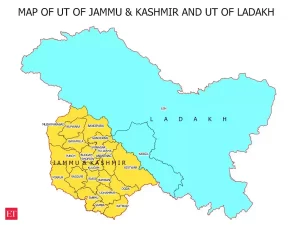06 Sep Ladakh to have India’s first ‘Dark Sky Reserve’ to promote astronomy tourism
News: Dr. Jitendra Singh, Minister of State (Independent Charge) for Science and Technology stated that by the end of this year 2022, India will establish the country’s first Dark Sky Reserve in the cold desert regions of Ladakh.
GS Paper 3: Science and Technology- Developments and their Applications and Effects in Everyday Life

What is a Dark Sky Reserve?
- A Dark Sky Reserve is public or private land with a distinguished nocturnal environment and starry nights that have been developed responsibly to prevent light pollution.
- Dark sky reserves “consist of a core area meeting minimum criteria for sky quality and natural darkness, and a peripheral area that supports dark sky preservation in the core.” as per the International Dark Sky Association (IDSA) website.
- These reserves are formed through a “partnership of multiple land managers who have recognized the value of the natural nighttime environment through regulations and long-term planning” as stated on the website.
- India is still in the process of filing its nomination to IDSA.
Why was Ladakh chosen for the project?
- Ladakh is a unique cold desert of India located about 3,000 meters above sea level with high mountainous terrains.
- Long and harsh winters with minimum temperatures dropping to minus 40 degrees Celcius make large parts of the Union Territory highly inhabitable.
- This barrenness, limited vegetation, high elevation, and large areas with sparse populations – all make it the perfect setting for long-term astronomical observatories and dark sky places.
- But the main objective of the proposed Dark Sky Reserve is to promote astronomy tourism in a sustainable and environment-friendly manner.
- Scientific methods will be used here to preserve the night sky from ever-increasing light pollution.
- With metros, cities, and peripheral areas experiencing light pollution and remaining constantly lit up, there are diminishing areas that offer a view of clear skies on cloudless nights, experts have noted.
Who is responsible for developing India’s first Dark Sky Reserve?
- The Ladakh Union Territory administration has taken the responsibility of establishing the country’s first Dark Sky Reserve.
- To be situated at a height of 4,500 meters above sea level, the Hanle Dark Sky Reserve (HDSR) will come up within the Changthang Wildlife Sanctuary.
- The Department of Science and Technology and experts from the Indian Institute of Astrophysics (IIA), Bengaluru, are providing scientific and technological support in developing this first-of-its-kind facility. The IIA already manages the Indian Astronomical Observatory (IAO) complex at Hanle, Ladakh.
- Now, here, scientists have been carrying out astronomical observations using the existing gamma ray, an infrared, and an optical telescope to study exoplanets, galaxies, and stars through the pristine skies of Hanle.
- The formal decision to set up this Dark Sky Reserve was made through a Memorandum of Understanding (MoU) signed between officials from the IIA, Bengaluru, the Ladakh UT, and the Ladakh Autonomous Hill Development Council in June this year.
How does it help Ladakh tourism?
- When Ladakh got its Union territory status, tourism in Ladakh has seen a boost during favorable months.
- Although, its insubstantial environment is vulnerable to rising carbon footprint and in-coming vehicles.
- The Ladakh Tourism Vision Document 2022 underlined the need for efforts to increase the use of green fuels and boost carbon-neutral activities.
- The locals in Ladakh are sensitive to the conservation of the ecosystem. They are keen to protect the environment from getting deteriorated. A number of initiatives are underway ahead of opening the Hazardous Discharge Site Remediation (environmental protection)HDSR to the public.
- In the first phase, the IIA has acquired ten small and easy-to-handle telescopes and light-reflecting shields.
- IIA’s scientists and outreach experts will identify locals and train them to use these telescopes, which will include basic sky gazing, identification of constellations, and locating the pole star, among others.
- These telescopes will be installed at the homestays, which is a popular option for tourist accommodation in Ladakh.
- The 22-km radius around the Hanle observatory, where the core Dark Sky Reserve will stand, will have restrictions imposed on outdoor lighting. All vehicles will be barred from using high-beam headlights. Houses here will be encouraged to use curtains of darker shades, install light reflecting shields and switch off all unwanted illumination.





No Comments